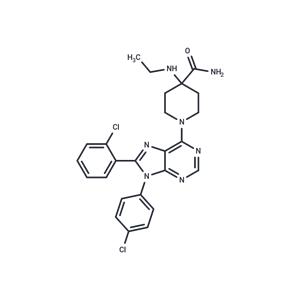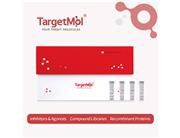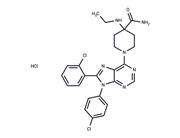| Name | Otenabant |
| Description | Otenabant (CP-945598) has been investigated for the treatment of Obesity. |
| In vitro | Otenabant HCl has a low Ki affinity for human CB2 receptors of 7.6 μM[1]. Otenabant HCl inhibits CB1 receptor with moderate unbound microsomal clearance, low hERG affinity, and adequate CNS penetration[2]. |
| In vivo | Otenabant effectively enhances energy expenditure and promotes fat oxidation in rats, alongside reducing the respiratory quotient, indicative of a shift towards greater fat utilization. When administered orally at a dosage of 10 mg/kg, Otenabant results in a notable 9% weight reduction over 10 days in mice with diet-induced obesity, after adjusting for vehicle effects. Additionally, Hydrochloride (HCl) form of Otenabant counteracts behaviors induced by cannabinoid agonists—including altered locomotor activity, hypothermia, analgesia, and catalepsy—triggered by the synthetic CB1 receptor agonist CP-55940. Furthermore, in rodent models, Otenabant HCl demonstrates a dose-dependent appetite-suppressing effect and increases both energy expenditure and fat oxidation. |
| Storage | Powder: -20°C for 3 years | In solvent: -80°C for 1 year | Shipping with blue ice. |
| Solubility Information | DMSO : 10 mg/mL (19.59 mM)
|
| Keywords | CP945598 | inhibit | Inhibitor | CP 945598 | Cannabinoid Receptor | Otenabant |
| Inhibitors Related | β-Caryophyllene | CB2 modulator 1 | Pregnenolone | Pregnenolone acetate | CB1 antagonist 2 | OMDM-5 | CB2 receptor agonist 2 | 2,3-Butanediol | Drinabant | AM281 |
| Related Compound Libraries | Bioactive Compound Library | Neuronal Signaling Compound Library | Membrane Protein-targeted Compound Library | Anti-Cancer Clinical Compound Library | Drug Repurposing Compound Library | Inhibitor Library | NO PAINS Compound Library | Bioactive Compounds Library Max | GPCR Compound Library | Anti-Cancer Drug Library |

 United States
United States



